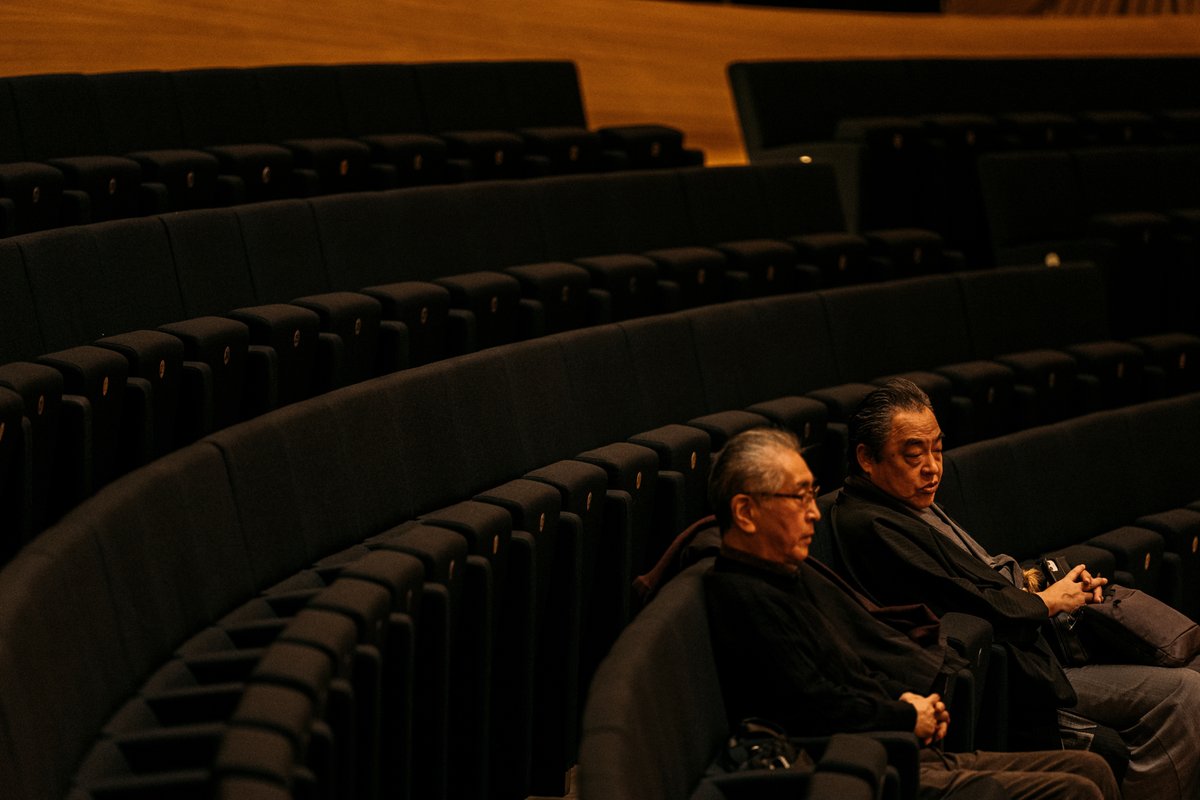
宝生流、アゼルバイジャンへ Vol.4 「公演を終えて、交流のよろこび」 The Hosho School of Noh Theater in Azerbaijan Vol.4 “Post-Performance: The Joy Of Getting to Know the Audience”
「パーティでアゼルバイジャンの方に『福の神を観て、両国にお酒を楽しむという共通点を感じ、私たちはとてもうれしいです』と笑顔で声をかけていただきました。普段は公演後にお客さまと言葉を交わすことはなかなかないので、とても印象的なできごとでした」と、旅を振り返って話してくれたのは、狂言方の野村拳之介師です。
「こんなにあたたかく歓迎していただけるとは思ってもいませんでした。みんな、歓迎を受けて驚いたんじゃないでしょうか」
After the Hoshos returned to Japan, one of the Kyogen performers Kennosuke Nomura, recalled: "At the post-performance reception, one of the guests remarked to me that he was happy to find out that both our countries enjoy a celebratory drink. Usually we don’t get to converse with the audience after a performance so that made a huge impression on me. And I think that the whole trip was a pleasant surprise. Personally, I didn't think we would get such a warm welcome.”


拳之介師はアゼルバイジャンの伝統文化にも感銘を受けたと言います。一同が公演翌日に観劇したマリオネット劇はアゼルバイジャンの伝統的な演劇芸術です。
「能や狂言とあやつり人形劇の共通点、つまり小道具を最小限に抑え、雰囲気と音楽に頼ったストーリー展開に衝撃を受けました。演者たちは操るマリオネットと一体化しているようで、そこにも共感しましたね。我々の面もからくり人形も表情が動くわけではありませんが、さまざまな感情を表現することができます。マリオネットの顔を少し傾けて悲しみを表現するのは、能楽で面をつけた人が悲しみや喪失感を表現するための動きと同じです」
Mr. Nomura was also impressed by the Marionette Theater performance in Baku’s Old City, where we were invited the following afternoon. The marionette play is Azerbaijan's traditional theater art.
"I was struck by the similarities between Noh and the marionette production - how the props are minimal and the story relied on ambience and music," said Mr. Nomura. "The performers seemed to be at one with the marionettes they were controlling and that too, resonated with me. Though Noh masks and the faces of the marionette dolls are both static they can be deployed to express a wide range of emotions. The slight tilting of a marionette's face to express sadness is something we do with a Noh mask, also to express sadness and loss."


アゼルバイジャンの伝統文化に感銘を受けたのは拳之介師だけではありません。家元も私たちもみな、マリオネット劇の美学には感銘を受けました。マリオネットの上演前には「日本とアゼルバイジャンは、どちらも長くて深い文学の歴史を持っています。これからご覧いただく物語は、アゼルバイジャン文学の最高峰です」と、演目の内容について座長が解説をしてくれました。
Mr. Nomura was not the only one impressed by Azerbaijan and its culture. The Hosho grandmaster and everyone else praised the aesthetics of the marionette play. Before the marionette performance, the director of the theater announced: “Both Japan and Azerbaijan have deep histories that are rich with literary treasures, The literary treasure you are about to see is one of Azerbaijan's finest."

マリオネット劇を鑑賞したわれわれはこうした上演前の解説によりその理解をぐっと深めることができましたが、ヘイダル・アリエフ・センターの我々の公演において観客の理解を深めるのに功を奏したのは、上演前の解説映像と、演目についての説明でした。演目について簡潔に分かりやすい説明を英語で行ったのは、シテ方の関直美師です。
We are able to draw much from the explanations delivered before the performances of marionettes. The night before at the Heydar Aliev Center, a pre-performance video and an explanation of the upcoming performances helped the audience gain insight into what they were about to witness. The explanation, written in English and delivered out loud by lead performer Naomi Seki, was both concise and helpful.
「宝生流で公演をするのは初めての国ですし、どのように説明すれば理解していただけるかということを考えました。また、とにかく第一印象を大切にして観ていただきたい、ということはお伝えしましたね」
日本でも上演前に説明を行うことはありますが、そういった場合と海外での上演前の説明には違いはないと直美師は言います。
「謡、囃子、面、装束……興味を持つきっかけはどこの国でも人それぞれです。900人いれば900通りの能があると考えています。観る人の想像力を引き出すのが能という芸能です。そういう意味では、とても好奇心旺盛に素直に楽しんでいただけたようで大変ありがたいと思いました。演者は舞台でその思いを受け止め、またお返しできたのかなと思います」
“Azerbaijan was a first-time country for us so I thought hard about the explanation and writing it in a way that would be comprehensible. Also first impressions are very important and I wanted to get that right.”
Ms. Seki writes pre-performance explanations for Japanese audiences too, and she says that the contents are the same as in English. “Whether it’s the ‘utai,’ ‘hayashi,’ the masks or the costumes, there’s are many entryways into the world of Noh. The interpretations and points of interest are up to the viewer. If there are 900 people in the audience, then there are 900 ways of interpreting the performance. Drawing on the viewer’s imagination is what Noh is about. The audience in Baku was very curious and enthused and their reactions were wonderful to see. I appreciated that so much. And I think the performers on stage drew on the audience’s enthusiasm, and reciprocated with their performances.“

今回の公演には、宝生流シテ方の辰巳満次郎師も同行しました。文化庁交流使として国内外で単独公演を行ってきた満次郎師は、アゼルバイジャン公演の合間に「日本人が考えがちな能のイメージを変えたい」と話していました。
「退屈で難解、眠くなってしまうというというイメージから、世界中誰が観ても面白くて分かりやすく、かつ息をのむものだというイメージに変えたいと思うのです」
Manjiro Tatsumi, who accompanied the Hosho School on this trip, has done solo performances both in Japan and overseas, the latter on behalf of the ACA (Agency of Cultural Affairs). Known for being open-minded and straightforward, Mr. Tatsumi says he wants to transform Noh from "boring, difficult, sleep-inducing" to "interesting, easily comprehensible and breathtaking" for audiences everywhere.
何百年にも渡り時代を反映して発展してきた能。「古の芸術でありますが、どんな時代にも果たせる役割があるのです」と、満次郎師は言います。そして、国内外を問わず能を観劇した人たちにはぜひワークショップに参加して能の動きや面を体験してもらいたいと続けました。
「能の真髄は舞にあります。能の舞には無理な動きはありません。むしろ身体に敬意を表するためのものなのです」
Mr. Tatsumi adds that for centuries, Noh performances have been a reflection of the times. "It's an ancient art form but it has relevance in whatever age." And whether abroad or in Japan, Mr. Tatsumi loves to have audiences participate in Noh workshops where they may experience Noh through body movements and mask-wearing. "The logic of Noh 'mai (dance movements)' is the logic of Noh itself - a coordination of movements that aim, not for exertion but to respect and revere the body.”

アゼルバイジャン公演については、「すばらしい機会だった」と満次郎師。「宝生流には多くの海外公演の招待をいただきますが、実現するのは簡単ではありません。今回、アゼルバイジャンで公演が実現して本当によかった。彼の地で能が上演されるのは初めてでしたから。これが成功したことは、宝生流のこれからを考えるためのよい指標になったと感じています」Of Azerbaijan, Mr. Tatsumi said: "The Hosho School gets a lot of invitations from overseas but many of them don't come to fruition. Azerbaijan followed through and we were all so pleased, not least because this is the first time that Noh had ever been performed in the country. It was an extremely wonderful opportunity and I feel that it's a good indicator of the future of the Hosho School."
宝生流能楽師であるとともに、東京藝術大学名誉教授である武田孝史師も、満次郎師と思いを同じくしていました。宝生流シテ方である孝史師は、家元がまだ大学4年生だった頃、宝生流の行く末を少し案じていたそうです。「日本の伝統芸術は衰退の一途をたどっており、先代の家元が亡くなった後、若い和英さんが後を継ぐことになりました。でも、心配することは何もなかったんです。今の家元は素晴らしい仕事をして船を整え、世界に漕ぎ出しました。当時、私は彼に『ただ上に立つだけではダメだ、父の足跡をたどるだけではダメだ』と言いましたが、家元はそれを受け止めてくれたんですね。私がこれ以上言うまでもないことですが、彼は宝生流を次のレベルに引き上げ、そこで元気な若手能楽師が芸に打ち込んでいます。宝生流の未来は明るいと信じています」【Vol.5に続く】
Mr. Tatsumi's sentiments were echoed by Takashi Takeda, who is professor Emeritus at Tokyo Arts University. Mr. Takeda is himself a lead performer of the Hosho School. He remembers that when the grandmaster was still a university senior he had been a little worried about the future of the Hosho School.
"Japanese traditional art was declining and after the death of the last grandmaster, the young Kazufusa was left to take charge. Actually I had nothing to worry about. The current grandmaster did an excellent job of righting the ship and sailing forth into the world. I told him that it wasn't enough to just be at the top of the Hosho hierarchy and it wasn't enough to just trace his father's footsteps. The grandmaster took it from there. I didn't need to say anymore, and he took the Hosho School to the next level, where a bevy of dynamic young Noh performers are committed to their craft. I believe the future is bright for the Hosho group.” 【Continued on Vol.5】


